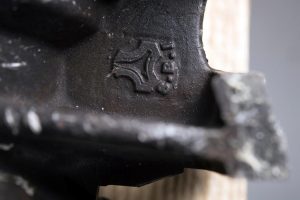Yemen’s Houthi rebels have fired another missile on a civilian target in the Saudi capital. The Houthis claim the missile used was a Burkan-2H, which recent evidence suggests is Iranian-supplied.
Earlier today, Houthi militants fired a short-range ballistic missile at Riyadh’s Yammamah royal palace, where the Saudi king was due to speak. The missile was reportedly fired from Yemen’s Sadaa governorate, a Houthi stronghold in the north of the country. The missile would have traveled over 800 km, an unprecedented range for Yemen’s pre-war stockpile, which strengthens the claim of Iranian support. The Saudi-led coalition confirmed the strike, but stated that it was intercepted and did not result in casualties.
The missile used in today’s launch, according to the Houthi claim, is identical to the one Ambassador Nikki Haley described in a presentation last week. On Dec. 14, at Joint Base Anacostia-Bolling, Haley briefed the press in a hanger filled with illegal Iranian equipment, including a missile that targeted a civilian airport in Saudi Arabia’s capital on Nov. 4. She invited members of the press, Congress, and international community to observe the evidence for themselves.
According to Haley, the missile’s distinctive features implicate Iran. The missile used in the Nov. 4 attack was a finless short-range ballistic missile (SRBM), which the Houthis call the Burkan-2H. Iran is the only known producer of a finless SRBM.  The missile also has nine valves, the array of which is consistent with the Iranian Qiam-1 missile. The missile actuator bears the logo of Shahid Bagheri Industries, an Iranian weapons manufacturer currently under American and European Union sanctions.
The missile also has nine valves, the array of which is consistent with the Iranian Qiam-1 missile. The missile actuator bears the logo of Shahid Bagheri Industries, an Iranian weapons manufacturer currently under American and European Union sanctions.
The missile’s composition points to Iranian manufacture as well. The missile used on Nov. 4 is made of aluminum alloy, which is consistent with an Iranian Qiam missile, according to Michael Elleman, a missile expert at IISS. Scud missiles, many of which existed in Yemen’s pre-war inventory, are composed of steel.
Haley argued that Iran’s provision of weapons to the Houthis violates UNSC Resolution 2231. Under this UN resolution, Iran is barred from testing and transferring nuclear-capable ballistic missiles and exporting arms and related material. In order to be considered a violation of the UN resolution, the weapons would have to be exported after its passage. But this timing was not immediately clear from the evidence Haley presented.
The focus on Iran’s support to the Houthis is part of a larger campaign to disrupt Iran’s destabilizing influence in the region. In Haley’s view, the Iran nuclear deal has “done nothing to moderate the regime’s conduct in other areas.” Rather, Iran believes it has been “given a pass” to destabilize the region. Haley alluded to further Iranian interference in Syria, Lebanon, and Iraq.








1 Comment
I suspect the THAD missile was used to shoot it down. These cost more than the SRBM; so eventually, the source of these missiles must be dealt with rather than just each missile. Perhaps after North Korea is settled.